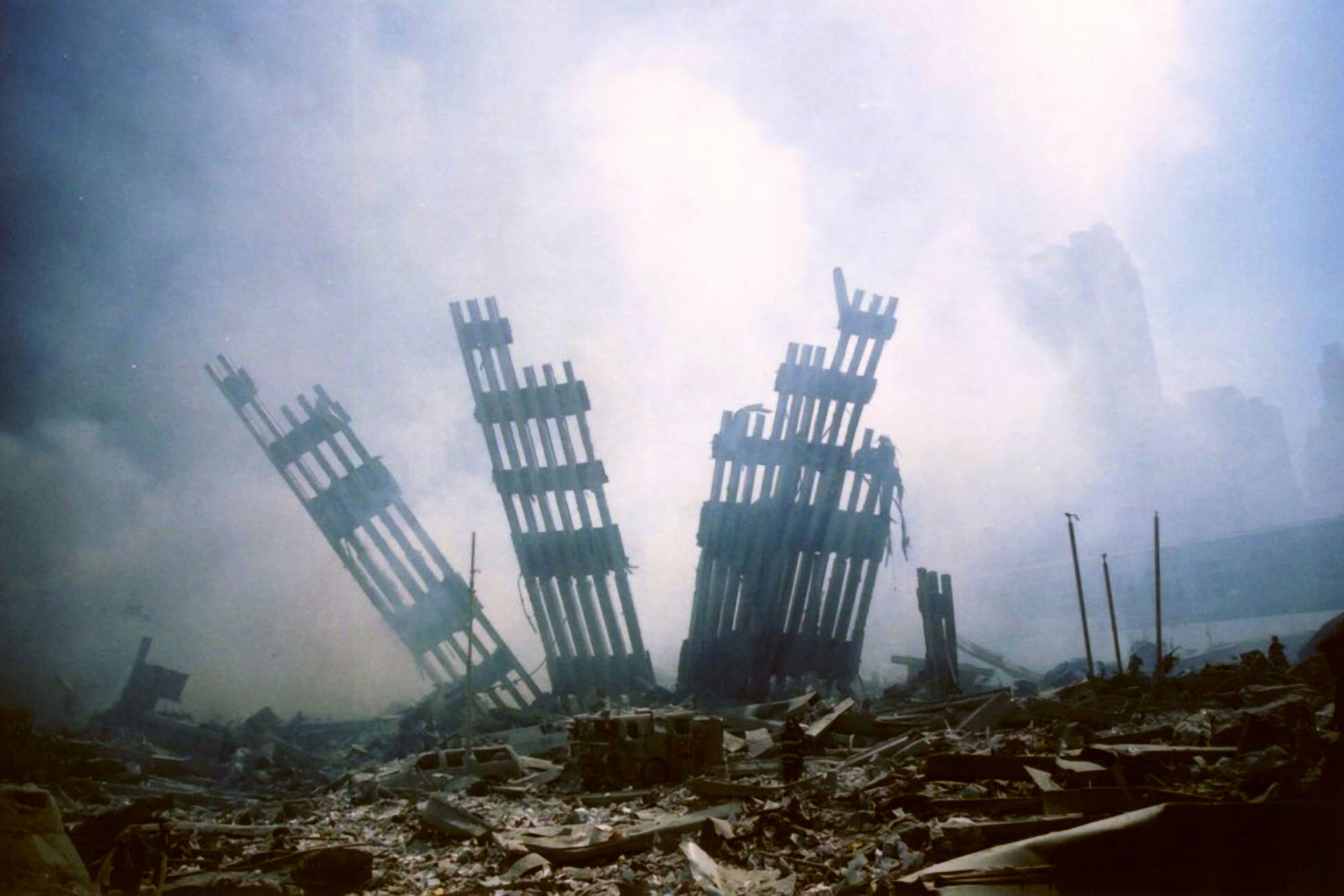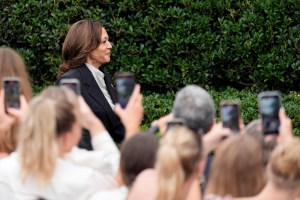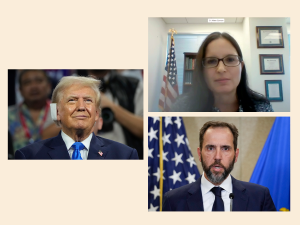
The ruins of the World Trade Center, 1:33 p.m., Sept. 11.
AP File Photo/Alexandre Fuchs
‘I never saw a survivor’
A first responder remembers Ground Zero
Minutes after David Battat responded to the 9/11 attacks on the World Trade Center as a volunteer firefighter, the north and south towers collapsed around him. Battat, a 1991 graduate of Harvard College, spent the next four days searching the site for survivors. He told his story to the Gazette.
I became a volunteer firefighter at 16, and I’ve been involved in disaster response since then. On Sept. 11, I was living and working in downtown Manhattan. I got two calls that morning. The first was from my mom, who told me a plane had crashed into one of the towers of the World Trade Center and that I should go down and help. As I grabbed my turnout gear and helmet, the phone rang again. Mark Smith ’91, one of my College roommates, was at the World Financial Center, directly across the street from the Trade Center. He told me people were jumping from the towers right in front of him and that his colleagues were evacuating the building. Mark delayed leaving because he wanted me to promise that I wasn’t going to go down there. I repaid this amazing, selfless act by promptly lying and assuring him I wasn’t going anywhere — I didn’t want him staying there. We still talk about it today.
I went out into the street and saw a long line of emergency vehicles headed to the towers. A police car with two officers stopped for me and on the ride there I made a mental checklist of things to do when we arrived. We ended up at the base of the north tower. What I had seen from a distance, and planned for in the car, didn’t prepare me for what I saw. It was such a beautiful day — a perfect blue sky, and warm. But at my feet were pieces of an aircraft engine and horrifically burned body parts of passengers. Above me, there was a deafening roar from the fireball. In the background, a firefighter screamed at us to keep looking up to avoid being hit by people who were jumping. I had three friends on the 96th floor. Like everyone else who knew someone who worked there, I took a moment to count down from the 110th floor to the fire. The 96th floor was engulfed by flames.
I was walking toward the south tower when the ground shook and there was a deep rumble. People were screaming and large chunks of rubble were crashing down. Sheets of pulverized concrete and glass made exposed skin sting. I ran toward a piece of fire apparatus hoping to find cover underneath it, but thankfully an NYPD sergeant ran out into the street and pulled me into a vestibule. We made it inside just as the last floor of the south tower collapsed. I was very, very lucky. There was a small group of people there with us, and we ended up having to call for help to get the door open.
“Over the next few days, I worked with a number of people — tourists who rolled up their sleeves, FDNY members, and a lot of construction workers. That’s the memory I keep in the forefront of my mind — thousands of strangers trying to help others.”
David Battat ’91
My phone rang just as we got out of the vestibule. I was in such a state of shock, I actually stopped and answered it. It was my dad. I was relieved to be able to tell him I was safe. Of course, when I hung up the phone, I looked to my right and my left and saw that everybody I had been with was gone. Incredible stupidity on my part. I don’t think I walked for more than a minute before the north tower came down. A friend who saw me just after this said I was completely covered in gray dust from head to toe, with two glowing eyes.
I washed off the dust and was directed to staff a triage center that supposedly was about to receive 500 survivors. After being there for a few minutes, it was clear this was more hope than reality, so I went back to the World Trade Center. The smoke and the scale of the devastation were overwhelming. The buildings were gone. Fire trucks, police cars, and ambulances were flattened. Smoke from the fires made it hard to breathe. Essential tools and supplies like leather gloves and masks were in short supply — we had to scavenge them from destroyed emergency vehicles.
Although the towers had pancaked, the rubble formed uneven peaks and valleys, making it impossible to see very far across the 16-acre site. People formed into self-directed search teams. Over the next few days, I worked with a number of people — tourists who rolled up their sleeves, FDNY members, and a lot of construction workers. That’s the memory I keep in the forefront of my mind — thousands of strangers trying to help others. I chose to work the north tower pile. I didn’t expect to find my friends, but I felt compelled to search there.
Navigating the pile was very difficult. While trying to look and listen for survivors under the rubble, we had to move slowly and carefully to avoid falling. There was no power on the pile, so darkness made the search harder, slower, and more frustrating. The bright lights of the city just a few blocks away were a jarring contrast. The attacks happened on a Tuesday, and the next four days were an endless series of heartbreaks. I never saw a survivor. Most people, including me, only found human remains, which were taken to what was then the food court of the World Financial Center. There were lots of papers and other personal objects in the rubble, but the sight of shoes — never in pairs — always stopped me in my tracks.
By far, the most personally painful experience happened after I left the pile. For the first couple of days, I avoided reading or watching the news and slept. I learned that two of my friends who worked on the 96th floor were lucky and hadn’t been at work when the planes struck. My other friend wasn’t so lucky. Stacey Sanders was 25 years old and died alongside 294 of her co-workers at Marsh McLennan. Her body was never recovered. At the memorial, just a week after the attacks, I learned that the father of one of Stacey’s closest friends, Richard Ross, was a passenger on the plane that hit her tower. Stacey’s and Richard’s names are listed side-by-side on the 9/11 Memorial.
The helmet that I wore hangs beside my bed to this day, so it’s one of the first things I see when I wake up. It’s a reminder to be grateful for each day, and for all the incredible acts of kindness I saw.








